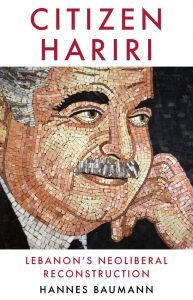|
Reviewed by Natalie Ghosn, Esq., Attorney at Law, Ph.D. Candidate, International Studies, University of Miami On February 14, 2005, then Prime Minister of Lebanon Rafiq Hariri was assassinated when the motorcade he was travelling in was bombed. This assassination, along with several high-profile assassinations prompted the development of an international tribunal for investigation, The Special Tribunal for Lebanon. At this moment, Lebanon was front and center on the world stage. While Hannes Baumann acknowledges the importance of this vastly publicized incident in his book Citizen Hariri, he argues that Rafiq Hariri had been significantly influencing and steering both politics and economics in Lebanon for several decades prior to his assassination, not only, in the aftermath of his death. With the political economy at the center of analysis, Hannes looks at the larger story and asks, “What does the rise of a man from the geographical and social periphery to the centre of politics tell us about the wider social, economic and political transformations in Lebanon?” (p. 3). In chronological order, tracing the evolution of Hariri’s life following his return to Lebanon in the post-civil war period, Hannes examines the economic and political development of Lebanese society. As the chapter titles denote, the book evolves along four main time periods commencing with Hariri’s rise from 1976-1990, the reconstruction of the Beirut city-center through the Solidere project from 1992-1998, the eruption of social crisis from 1998-2000 which resulted in a necessary sectarian turn for Hariri and Lebanon’s return to political crisis and Hariri’s assassination from 2000-2005. Hariri was immune from the day-to-day civil war in the 1970s and spent this time in the Gulf working as a contractor, specifically, in Saudi Arabia. Hannes explains that the “civil war was an unfortunate interruption of Lebanon’s free-market model” (p. 4). Upon Hariri’s return to Lebanon he pushed for two primary reforms which he hoped would jump start the Lebanese economy and attract foreign investors to the Beirut city-center. As Hannes astutely puts it, it “is hardly surprising that a contractor would regard an urban megaproject as the key to economic success” (p. 169). The first reform was the “Solidere megaproject to reconstruct central Beirut” and the second was “the anchoring of the Lebanese pound to the US dollar” (p. 11). Unfortunately, Hariri’s policies did not achieve their desired result. As Hannes explains, “Hariri’s policies concentrated wealth, resulting in high unemployment and continued poverty, while most Lebanese remained dependent on politicians for the provision of jobs, education or health care” (p. 114). All the factors that contributed to this result, including the widespread use of resources devoted to rent-seeking activities, are examined in Hanne’s work. With emphasis, Hanne’s explains how, in the case of Lebanon, neoliberalism reproduces “the political economy of sectarianism” (p. 116). The role of sectarianism in Lebanese politics and economics, with a close examination of the relevant actors, is thoroughly examined in this work. This book provides the background needed to understand, not only the internal Lebanese economy of past decades, but also provides insight for today shedding light on Lebanon’s intricate relationship to other nations, like the Gulf Arab States, Syria, the USA and France. With Hannes succinct writing this is a fast-paced must read for those interested in the political economy of the Middle East. |


 Citizen Hariri: Lebanon’s Neoliberal Reconstruction
Citizen Hariri: Lebanon’s Neoliberal Reconstruction